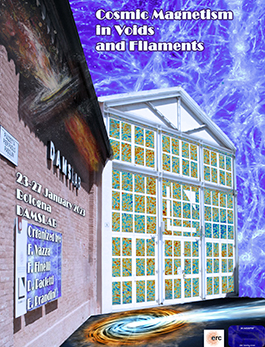Conveners
Thursday
- Manuel Meyer (University of Southern Denmark)
Thursday
- Gabriele Giovannini (Istituto Nazionale di Astrofisica (INAF))
Galactic outflows driven by starbursts can modify the galactic magnetic fields and drive them away from the galactic planes. I will present a novel approach to quantify the magnetic field in the galactic wind of the canonical starburst galaxy M82. We used HAWC+/SOFIA polarimetric observations and a potential field extrapolation commonly applied in solar physics. I will present the modification...
Primordial magnetic fields can enhance baryon perturbations on scales below the photon mean free path prior to recombination. However, these perturbations are suppressed if the magnetic Jeans length scale becomes larger than the scale of the perturbation. In this work, we show that the growth of baryon perturbation also causes a growth in dark matter perturbation, and the latter is not...
The parameter values of the extragalactic magnetic field (EGMF) presumably filling the intergalactic medium remain largely unknown. One of the possible methods to better constrain the EGMF parameter values is to observe blazars with hard spectra and compare the characteristics of the observed gamma-ray emission with model results, since observed gamma rays may be secondary in nature, with...
Numerical simulations can substantially support the study of the origin of cosmic magnetism. Simulation projects that simultaneously consider a plurality of seeding scenarios, resolve amplification processes and reach cosmological scales are however still somewhat scarce. Leveraging on algorithmic advances at the heart of the novel cosmological code SWIFT, and developing concurrently a suite...
Mpc-scale diffuse radio emission, known as radio halos, are the best evidence of accelerated particles and magnetic fields in galaxy clusters. In the last decades, new low-frequency arrays have sensibly increased the number of clusters hosting diffuse radio emission, reaching also the poorly explored high-redshift regime. In this talk, I will present the results on LOFAR observations of...
Primordial magnetic fields (PMFs) are possible candidates for explaining the observed magnetic fields in the Universe. In general, there are two competing scenarios of primordial magnetogenesis: inflationary and phase-transitional. In this work, we study the amplification of both inflation- and phase-transition-generated PMFs in a forming galaxy cluster using magnetohydrodynamic cosmological...
Faraday rotation studies of distant radio sources can constrain the evolution and the origin of cosmic magnetism. We use data from the LOFAR Two-Metre Sky Survey: Data Release 2 (LoTSS DR2) to study the dependence of the Faraday rotation measure (RM) on redshift. By focusing on radio sources that are close in terms of their projection on the sky, but physically unrelated (‘random pairs’), we...
Primordial Intergalactic Magnetic Fiels (IGMF) are a long-lived cosmological question, they could have played a crucial role in the early evolution of the universe but efforts to discover its properties have been so far inconclusive, with only limits put in place using different methods and techniques, current limits allow strengths between $10^{-7}$ nG and 1 nG for a coherence length of 1Mpc....
We discuss the possibility of non-linearity in baryon inhomogeneities during cosmological recombination.

